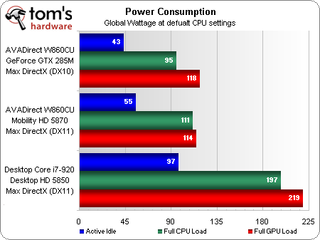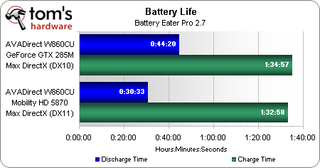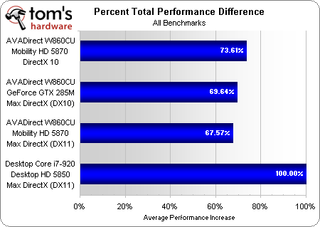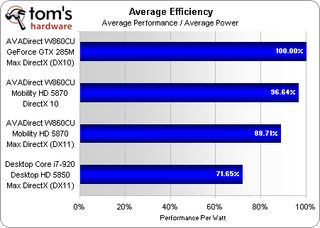AVADirect's W860CU: Mobility Radeon HD 5870 Vs. GeForce GTX 285M
Custom system builder AVADirect is one of the few companies to offer the flexibility of multiple graphics modules within the same notebook model. We used its high-end W860CU to compare AMD's and Nvidia's highest-performance mobile graphics processors.
Power, Efficiency, And Battery Life
Given its Radeon HD 5770-based architecture, we are surprised to find the Mobility Radeon HD 5870 with higher idle power than the GeForce GTX 285M. Because it’s part of global wattage measurements, higher GPU idle power also affects the CPU Full Load test reading. The GeForce GTX 285M has higher GPU load wattage, while far higher power draw for the desktop platform shows why these types of parts are not used in notebooks.


Battery Eater Pro runs a small 3D demo continuously. Given the Mobility Radeon HD 5870’s lower load power, we are surprised to see that the unit provides less battery run time. A relatively short battery life from a desktop replacement makes it worth considering the spare battery option if you spend a lot of time away from wall sockets.

The average performance chart above gives us the “work” side of the efficiency equation.

AVADirect’s GeForce GTX 285M build edges out its Mobility Radeon HD 5870 version. The desktop PC’s superior graphics performance softens the fact that it isn't as efficient as the AVADirect notebooks.
Stay on the Cutting Edge
Join the experts who read Tom's Hardware for the inside track on enthusiast PC tech news — and have for over 25 years. We'll send breaking news and in-depth reviews of CPUs, GPUs, AI, maker hardware and more straight to your inbox.
Current page: Power, Efficiency, And Battery Life
Prev Page Benchmark Restuls: DiRT2 Demo And S.T.A.L.K.E.R.: Call of Pripyat Next Page Conclusion-
ta152h I'm a little confused why you'd choose an i7 920 to compare with a different platform, but maybe it's because I don't know the mobile platform that well.Reply
But, if it's like the P55, which it seems to be, there's the added uncertainty of the architecture thrown in.
Particularly with PCI-E being implemented differently, you might be seeing the inferior implementation of the P55 architecture responsible for a small amount of the relatively poor mobile performance. Since this implementation needs to multiplex the memory bus of the processor, you can run into situations where there is contention.
I doubt it's significant, but I'm curious why you wouldn't want to make a comparison with a more similar desktop platform. Was it because you couldn't get an unlocked Lynnfield to get the clock speeds for the processors the same in Turbo mode?
-
This doesn't make much sense to me... if a 5870M chip = roughly a 5770 desktop chip and a 285M = roughly an 8800gts.. why is it not completely spanking it? we all know 5770>8800.. by a rather large margin! what could be the cause of this?Reply
-
anamaniac Tom's, you should show your power usage results to AMD and ask for an explanation, on why a lower rated part is using more power.Reply
Granted, with a 45W CPU and 50W GPU, 30 mins is expected on a 40W battery if fully stressed. -
jkeopka I liked this article because I found it so darn relevant... I actually have this same Clevo Laptop, with the 5870 and 8 gigs of RAM.Reply
The GTX 285M was a $50 premium over the 5870, and I am glad I chose to stick to the 5870. It is kind of strange one would pay more to have less performance. I guess thats what fanboyism are all about? -
jkeopka anamaniacHow many partners use Clevo laptops and just rebrand them?Lots. Mine is a Sager 8690... which is a rebranded Clevo W860CU...Reply
I have seen this model at other sites as well. -
falchard Looks more like a bottleneck then anything conclusive. The results in nearly all the tests were close, yet 1 of them should have been clearly ahead.Reply
I think an ASUS JH73-A1 verse this would have been more interesting as its a bit cheaper for better parts. -
Crashman TA152HI'm a little confused why you'd choose an i7 920 to compare with a different platformSame speeds in Turbo mode, which is used during games, the primary focus being gaming performance.TA152HBut, if it's like the P55, which it seems to be, there's the added uncertainty of the architecture thrown in.That's true, but neither graphics solution provided the performance needed to highlight the mobile processor's on-die PCIe controller's performance advantage.TA152HI'm curious why you wouldn't want to make a comparison with a more similar desktop platform. Was it because you couldn't get an unlocked Lynnfield to get the clock speeds for the processors the same in Turbo mode? Exactly. Besides, Tom's Hardware has already seen that clock-for-clock, Lynfield games at least as well as Bloomfield when a single card is used. If nothing else, the comparison favors the mobile solution's lower power consumption.Reply
Most Popular


